(PAGE 3):

(PAGE 5):


SPORTS (PAGE 8): FANTASY FOOTBALL FEVER


(PAGE 3):

(PAGE 5):


SPORTS (PAGE 8): FANTASY FOOTBALL FEVER

By Angela Cao, Sarah Wu, and Tycho Young


As students returned to BASIS Independent Fremont Upper (BIFU) this year, they were met with a familiar presence: the resurgence of our school mascot, the yellowjacket. Every day during lunch, they take flight, attracted by the aroma of students’ lunches.
To further investigate the impact of the problem, a survey was taken with 53 BIF students asking questions about their experiences with the insect. Because the survey only received three responses from middle school students, and they are a separate demographic, they will be excluded from further analysis.
When asked to rate the yellowjacket’s level of disturbance on a 1-10 scale, students gave an average rating of 7.84 and reported seeing an average of 4.61 yellowjackets each day. Among the 50 responses, six incidents of sting -
ing were reported. These wasps can get quite aggressive when provoked. Along with these disturbances, students also said they were confused about the difference between bees and yellowjackets. To be clear, yellowjackets and bees belong to different biological families. Yellowjackets are a type of wasp, far larger and more aggressive than most bees, and can sting repeatedly.
The surveyed data also shows a correlation between where students sit and how many yellowjackets they interact with. It indicated that yellowjackets are more concentrated in certain areas, with the further the seating location from the woods, the fewer yellowjackets noticed. Most students expressed a negative view toward the presence of yellowjackets.
Yellowjackets have also impacted
students’ ability to eat their lunch.
“When I see a yellowjacket, I run away and then I can’t eat my lunch. When I run away frequently enough, I can’t eat enough,” said Chen Ma (10). “Children my age really need to eat their lunch because I’m still growing and if I can’t eat my lunch, I can’t grow.”
Since many students found yellowjackets to be an area of concern that is affecting their lunch experience, we looked into how the school is addressing the problem.
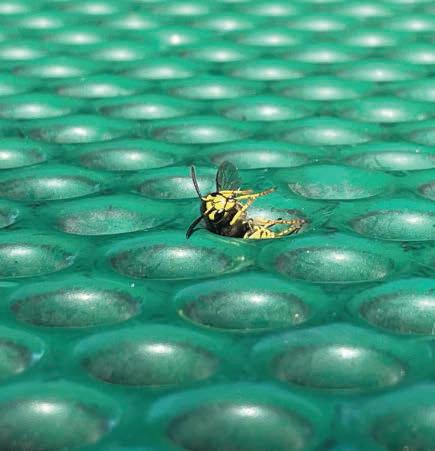

While student safety remains a top priority, Ms. Apra has also expressed the various complications that arise in handling the situation, given the role of yellowjackets in the environment.
As for the solution, Ms. Apra, the Director of Operations at BIFU, recently made it clear that the school is aware of the yellowjacket infestation and is actively taking measures to manage it.
“Constant efforts are being made to remedy the problem, with different levels of success,” said Apra.

“It’s a delicate balance between wanting to just get rid of them completely and not disrupting nature” said Ms. Apra. “They’re good for the environment and native to California, so it feels wrong to just eliminate them.” It is clear that balancing maintenance of natural habitats with student safety and comfort is a difficult task. As part of the school’s efforts to resolve the issue, they have implemented a variety of natural solutions. Peppermint oil is applied daily on all surfaces of the yard.
While previous removal efforts worked in the short term, they were unsuccessful in creating a permanent solution to the problem. Last year, various traps were placed around the campus. The traps were effective for a couple of weeks, but the yellowjackets then began to slowly re-emerge. Now, the school has signed a contract with an exterminator who might be able to fix the problem once and for all.
In the meantime, students may have to adapt to the situation. Yellowjackets are more prominent in certain areas, particularly near the trees, so moving away from these spots may help. But by far, the best way to deter the yellowjackets is to avoid attracting them in the first place.
In our survey, students who ate meat saw more yellowjackets on average. Consider packing vegetarian meals or covering containers to reduce attraction. Above all, clean up any food scraps, and if a yellowjacket approaches, stay calm— swatting at them can prompt them to become aggressive.
Ironically, despite being a nuisance, yellowjackets are also the school’s mascot. “I feel rather amused with them being our mascot,” said one student who chose to remain anonymous, “It makes the situation slightly hilarious.”
By Thanisha Thambidurai
A flurry of students crowds the hallways at 3:15 p.m. sharp, ready for their days to sort of end. While they shove items into their bags, students are surrounded by the sounds of their peers conversing, lockers slamming shut, and the Head of School, Ms. Abodouma, reminding everyone that backpacks should remain in the lockers.
The 2024-25 school year is introducing perhaps the most significant change BASIS Independent Fremont Upper (BIFU) has made: by shortening each class by five minutes, school administrators have adjusted the schedule to end at 3:15 p.m., leaving the remaining time until 4:00 p.m. for office hours. To understand how students feel about this
schedule change, a survey was conducted, with most reviews coming back as favorable.
Prior to the scheduling shift, students were regularly complaining that classes ended at 4:00 P.M., as opposed to other schools which end earlier. Many students often felt tired as the school day dragged on, especially in classes after lunch. It is not uncommon to find a classmate, or even oneself, dozing off during a lecture simply because the individual felt the class was too long, not because the lecture was boring.
The new schedule allows for only a slightly shorter class period yet manages to leave students with forty-five minutes of additional time at the end of the day. Multiple students expressed their gratitude towards the new bell schedule due to the extra free time.

By Aarna Kamath and Pooja Kanthala
A&E Editor & News Editor
A new school year means new teachers, new classes, and new friends. For students, it also means a new school lunch system. This academic year, the BASIS Independent Fremont Upper (BIFU) admin introduced the My Hot Lunch system, turning the tide on school lunch.
While many students enjoyed the previous school lunch, there were some

negative sentiments towards it as well. Previously, some students had complained of hygiene issues.
One of them reported finding a dead spider in their lunch, and others complained of a lack of variety.
“I wasn’t too happy with it,” said Angela Cao (10). “Most of the time the food

“It gives me more time to do work during office hours at the end of the day and feels like the classes have gotten more productive”, said Niyam Chatwani (9). “I think it’s one of the best decisions BASIS has ever made.”
Chatwani expresses that the shorter class periods increase productivity, likely due to the class being conducted faster and with a sense of urgency, something that was lacking when students had a couple of minutes to settle in and pack up at their own pace last year. Further commenting that he believes it is one of BIFU’s best decisions, Chatwani indicates the usefulness of the schedule change and his desire for it to not revert back to the 50-minute classes.
we ate would be cold. It’s not very nutritious.”
The new school lunch system sought to replace the previous lunch options with catering from well-known fast food chains, such as Nick the Greek and Dominos. Not only did this add variety, but it also provided BIF students with more familiar and beloved food items
So far, the new school lunch has been met with positive feedback.
“I like this year’s school lunch menu since it’s much easier and faster to order,” said a BIFU parent who wished to remain anonymous. “It’s a daily menu with restaurants that the kids like, so
Another benefit of the new schedule is the ease of making up missed tests, as expressed by Shubh Bachkethi (9). Although he states that he is not entirely accustomed to the new class timings, he shares his experience with retaking a computer science test, which proved convenient given the extra time after school.
“I retook my C.S. test today”, Bachkethi said, “and it was a breeze, unlike when I’d miss a test in middle school.”
However, not everyone is fond of the new class period. While many people appreciate the time to meet with teachers after school, some feel that attending mandatory office hours after school is irritating and can get tiresome.
Nick Lin (8) shares that he feels the office hours being required is not necessary, although he does appreciate the shorter class times. This sentiment was shared among other students as well.
“I just want to go home after school, but now we have to go to office hours”, said Lin, “I get what they are trying to do, but it gets annoying sometimes.”
Yet, not everyone finds themselves much affected by the change. To some people, five minutes can be just the right amount of time to keep them engaged in the class; to others, it does not make a difference in their learning experience. In the end, the length of a class period doesn’t always determine its productivity, but shorter class periods may appeal to some people.
“It feels the same”, said Chen Ma (10).
there’s less of a hassle in choosing food to eat.”
Some students who previously never bought school lunch have tried the new meal options. Additionally, the lunch line by the snack shack has become noticeably longer.
With more students opting to eat from restaurants they know and love, choosing to eat school lunch has become an easier experience.
“I really enjoyed the new menu”, said Richa Charora (11), “and I’m looking forward to whatever food they introduce next.”
Graphics by Canva.com
By Sheil Mody and Vincent Yang
A&E Editor & Opinion Editor
As students returned to school for the 2024-2025 school year, they were greeted by the familiar faces of their classmates and the familiar spaces of their classrooms, but the campus itself seemed to undergo various minor changes.
Previous years featured the completion of the circular hallway, new paint jobs, and other miscellaneous renovations, and this year saw no deviation from the trend. Returning students may have noticed something off about the school upon setting foot within the premises—the carpet in the back hallway and Room 116 had disappeared.
Few students could have fathomed that the carpeted floor, a feature dating back to the very origins of Basis Independent Fremont Upper (BIFU), would
be a target for extermination, as it never was, in the eyes of the student body, a pressing matter that deserved such attention. Now that it is gone, some have come to sorely miss its presence, finding the current aesthetic of the hallway to be monotonous and uninspiring.
“Though it seemed musty to some, it provided a sense of comfort and a sense of personality to the rooms”, said Sachit Parekh (12), “[The current hallway] is a departure from the previous cozy feel of the back half of the campus.”
The carpet certainly seems to be a symbol of nostalgia for those who have long attended this school. However, the decision to remove the matting was widely considered by staff and students alike to be a practical one, aimed at simplifying the process of sanitizing the hallway, improving the general aesthetic of the school, and bringing it in line with the BASIS brand.


“It was just not appealing”, said Head of Upper School Abodouma, “and it was part of the church’s furnishings. We wanted to make the floor the same as all the other BASIS schools.”
Many-a-student agrees with the reasoning behind the decision, denouncing the carpet as a scourge that contributed to lower hygiene and a rather banal vibe overall. These individuals welcomed the changes with open arms.
“I love the new floor. It’s way easier to clean than carpet and feels more sanitary,” said Julee Jiang (12), “The carpet had so many bristles—who knows what’s stuck in there? At least floors have all the dirt on the surface.”
This seems to be the more popular opinion, as most harbor no attachment to the carpet of olden days, instead appreciating the new rational design of the hallway. Though strong opinions
the carpet purge certainly exist, most people simply don’t pay any mind to the changed composition of the hallway or the room.
“I didn’t really notice it until now,” Joshua Ni (12), “but I suppose it’s good for the janitor.”

By Olivia Ma
Trigger Warning: Mention of school shootings. Please proceed with caution.
BASIS Independent Fremont Upper (BIFU) has long followed a personal device policy: no phones allowed during the school day. However, recent changes, such as a new rule seemingly banning listening to music and no laptops allowed outside at lunch, has sparked controversy amongst students.
Cell phone possession should be allowed at all times at BIFU, and its use should be allowed outside of class time: students need access to personal devices in cases of emergency, and a complete ban on cell phones outside of class is extreme. The administration’s enforcement of the cell phone policy should also be more straightforward and consistent.
One of the first issues with the cell phone policy was its initial lack of clarity — not in writing, but in enforcement. The policy states students are not allowed to use their phones from the beginning of the school day 8:25 a.m., to 4 p.m.
For seniors, whose days often end at 7th or 8th period, students are permitted to use their cell phones once classes are over. Despite the boundaries of the policy, a few members of administration often verbally disciplined seniors for cell phone use after their day was over, which caused confusion for students.
However, after students told Head of Upper School Abodouma how they felt, such conflicts have stopped. For the sake of students and faculty, it is important to maintain clear communication and consistent enforcement.
Furthermore, the headphone/earbud “ban”, a new rule this year accompanying the cell phone policy, has supposedly barred students from using earbuds in any setting, including listening to music at any time. However, the rule simply states students cannot use it in connection with their cell phones, or to watch non-academic or entertainment videos.
Music is still permitted.
Beyond miscommunication within administration, cell phone policies around the nation — not just BIFU — have been a controversial topic regarding emergencies. Cell phones stand as a necessary form of communication in emergencies.
Recent viral images from the tragic Apalachee High School shooting depict students texting their parents, informing them of the situation at hand, with both attempting to comfort each other.
According to the Public Policy Institute of California, school shootings occurred once every six days statewide on average in 2023.
In such a frequently life-threatening situation, the absence of a cell phone impacts a student’s ability to notify their families of their condition, and hurts all parties involved.


Members of BIFU administration have claimed texting in such situations only freaks out parents and blocks law enforcement and medical personnel from entering the school. While it is important for authorities to have access to the campus, it is more likely the city’s resources would arrive before enough parents—who are likely at work or have other commitments—could significantly block all entrances.
Furthermore, learning of such a highrisk situation from school administration, then not hearing from their child because they do not have access to their cell phones would inflict mental and emotional stress and anxiety on both parents and students. In this way, students without their cell phones cannot receive any words of comfort from parents, and parents cannot stay updated on their child’s status, having to wait until the ordeal is over to find out.
The policy is mostly in place to regulate a student’s everyday life, specifically during class. Although it makes sense to keep cell phones out of sight during class — but nearby in case of emergency — they should not be banned during lunch on campus. Administration has argued that students should focus on
physical interaction, rather than being glued to their screens all day.
While it is important for children and adolescents to get exercise and take real breaks, completely banning cell phones and confiscating them on sight is too extreme. Breaks are meant for students to devote their time to themselves, without the strictness and instruction of a classroom.
Moreover, taking away cell phones can result in friction between students and faculty, with students feeling their personal property and freedom is taken away, and they cannot be trusted to manage themselves. Instead, administrators should greatly encourage students to rest without a device, and still give them space to make their own decisions.
There is not a big enough reason to bar students from solving private matters outside of class time. Making them use the school phone under administrator supervision restricts their independence and privacy.
BIFU, an institute that says it promotes student independence and nurturing, should end such a restrictive and potentially unsafe policy.
By Hemangi Ghimire Staff Writer
The 2024-2025 school year has already begun, with teachers handing out homework and exams, with one catch: not all students have received their materials yet, making it difficult for students to do their work. Therefore, the BASIS Independent Fremont Upper (BIFU) textbook list needs to be finalized during the summer before school starts.
The school usually sends out the textbook list around late June. But this year, it was not yet finalized by the time school started. Moreover, a huge portion of the textbooks used in class were not mentioned by teachers in the unfinished list, leaving students unaware of key materials needed in their classes.
Students in BASIS Independent Fremont Upper School have agreed with
this statement based on their experiences with acquiring materials.
“I feel that they should confirm the textbook list at least one month earlier,” said Meher Wadia (9), “Some teachers do not even know their textbooks until the beginning of the school year. By the time teachers start their lessons, students don’t have their textbooks or have anywhere else to reference (the materials].”
There are plenty of examples of the current system negatively impacting many students’ education. Students end up being ill prepared for classes. A missing textbook hinders a student’s ability to learn the material and to prepare for their exams. It also might force students to seek alternatives, such as borrowing from another student, causing an inconvenience to everyone. Many students across campus have encountered these problems surrounding the issue.

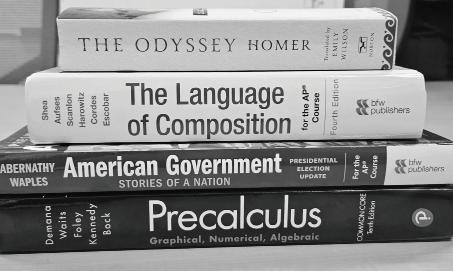
“[The current system] has negatively impacted me because I still have not received my AP U.S. Government textbook and we are getting assignments that require the textbook”, said Saanvi Atluri (9). “Our quizzes are also heavily based on the textbook.”
Not finalizing textbooks early on extends further than students’ learning getting hampered, though.
“If they do it after school starts, everyone will be rushing to buy [their textbooks],” said Hailey Schmerge (9), “Textbooks will be sold out and only some students are able to buy the materials necessary and get their hands on it immediately.”
This not only hurts the students, but this causes a problem for parents as well. If textbooks are already sold out on popular and well-known sites like Amazon, parents have to do extensive searches or other platforms to purchase the required materials. This could result in materials being more expensive, greater waiting times, the packages being lost, or other unpleasant experiences.
It is clear that all these problems could be solved by releasing all materials on the textbook list in a timely manner.
“If we got the finalized textbook list during the summer, we would have our textbooks by the first week of school,” said Atluri, “It would be easier for teachers, students, and parents alike.”
By Natalie Luo and Emma Ma
The old-school method of studying by endlessly staring at a textbook and re-reading class notes over and over again is totally outdated—there are plenty of more effective approaches to getting good grades. What better place to find such approaches than in a school full of students dedicated to maintaining a perfect academic record? Among these students, there is a diverse range of study strategies, each suited for different needs and preferences. We interviewed BASIS students across multiple grades, and found that some of the methods that were shared with us are incredibly useful, while other methods are not. For instance, our favorite methods include doing practice problems, using textbooks and various other sources, and the Feynman technique. The “method” that we look down upon the most is relying solely on re-reading your class notes, as we believe that doing so will get you nowhere.
Relying just on your notes or memories of classes is an extremely ineffective way to study. Studies have shown that students who read over material once perform just as well as students who read over material multiple times (Stromberg, par. 4). This is because after the first read,
the brain only recognizes the information but doesn’t try to process it deeply. This makes it harder for the knowledge to be stored in your long term memory. It gives students the illusion that they are familiar with the subject, when in fact there are some unfamiliar points in their memory. An even worse study technique is to only ruminate about the information that you remember hearing about in class. This method relies on your ability to quickly memorize information accurately. If you are confident in your prior knowledge of the topic, this method may work for you, but we would not recommend it. If your memory is skewed just slightly, you could end up storing inaccurate information in your long term memory, causing you to make mistakes on assessments. A better technique is to utilize active recall, which involves questioning yourself to retrieve information without prompts. This retrieval of information helps build permanent memories, and the inability to retrieve information about certain topics allows students to identify their weak points.
One of our favorite study methods is doing practice problems, as they not only help you become more familiar with concepts, but they also help with identifying gaps in your knowledge. When you work through multiple problems, you’re able to see if you’re consistently making the same mistake at a particular step, allowing you to then find a way to correct it. This method works best with math because it’s all about constant repetition
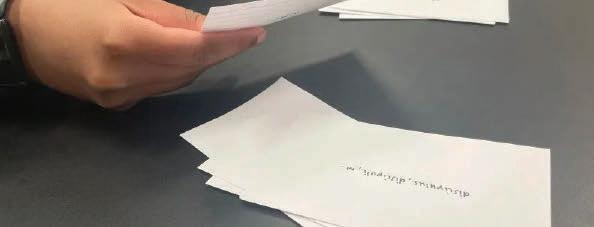
and knowing how to consistently apply the same concepts in different scenarios. From experience, once you do the same thing over and over again for a while, it’ll eventually be imprinted in your brain.
Another method that we love is utilizing resources such as textbooks and videos.
Nicole Lin (10) said, “My favorite study method is to read the textbook while taking notes. I’ll also look over the review questions in the textbook.”
Textbooks typically have the same content taught in class but explore the topics more deeply, which can help with better understanding of the material. For example, reading a biology textbook while studying for a macromolecules test can be extremely helpful, because it’ll include lots of detailed diagrams and charts that offer visual learners an easier way to absorb information. Sometimes when you’re listening to a lecture in class, you’ll tune out the words and end up learning absolutely nothing. Resources like textbooks offer more engaging ways to learn, such as visual aids.
Another extremely effective method is the Feynman Technique. With this study method, students who are learning a difficult or complex concept try to simplify and explain their concept to someone else.
Diya Singh (7) said, “My favorite study method is taking notes on the material and then teaching it to my parents.”
We both like to use our parents as audience members as well when using this method, because they’re always nearby. After attempting to teach the material, students can then identify holes in their explanations or parts that they are unsure of, and focus on studying those parts. This method is very well-known and helpful for understanding difficult concepts. It also works for many different subjects, making it very versatile.
If you are trying to memorize a lot of information, you can utilize a mnemonic device. A mnemonic device is an acronym where each letter represents something that you are trying to memorize.
“I like to come up with ways to make things easier to remember, like acro -
nyms. This helps me a lot in history especially. I definitely recommend this method—remember to make it as simple and engaging as possible,” said Anuva Dixit (8).
A popular example of a mnemonic device is PEMDAS, commonly used to help remember the order of mathematical operations: Parentheses, Exponents, Multiplication, Division, Addition, and Subtraction. Mnemonic devices are extremely helpful when trying to recall information because it allows the brain to store large amounts of information in a way that it understands, meaning that students are able to recall the information more efficiently.
Another great method is the Leitner System, which we recommend for memorizing vocabulary. The Leitner System is a type of spaced repetition that involves using flashcards. Spaced repetition is a learning technique that involves reviewing material at increasing intervals to improve long-term retention. Firstly, the student will write down vocabulary terms and their definitions on flashcards. Next, the student will set up a series of boxes. They will start by putting all the flashcards into the first box. Then, they will go through each flashcard and see which definitions they remembered. Every time they get a term correct, they will move the flashcard into the next box, and if they get the term wrong, they will return it to the previous box. At the end of this process, the flashcards that end up in the closest boxes will be studied more frequently, while the flashcards that are remembered consistently and therefore moved further down will be studied less often. Since this technique allows students to focus on repetition and active recall, it’s especially effective for memorizing large amounts of information.
In conclusion, there are countless productive study methods that are worth your time. With the Feynman technique, spaced repetition, and everything in between, there must be something for you. Just remember to stay away from passive methods like re-reading notes, and you’ll be all set to score high grades in every subject.
By Aaron Ely Staff Writer

As the school year begins, one of the most common questions asked between students is, “What did you do over summer?” Although students may receive different answers from their close friends, a larger sample size can provide a more comprehensive view of how students spent their summer break.
To gather this information, a survey was conducted to explore the different ways students spent their summer. For simplicity, the responses have been split into different categories: traveling, educational/academic experiences, and movies and books.
Traveling during summer is common amongst students, as it is the longest break during school, which provides students with plenty of time to visit new places. According to the survey, most students traveled domestically, with two-thirds of students staying in the United States. Within this group, there was an even split between those who traveled within California and those who traveled to other states.
The re maining one-third of students traveled internationally, with most of the destinations in Asia and Europe. These trips were made independently, not as part of any school-or
ganized programs. One student traveled to Canada, while South America and Africa were less common destinations, indicating that most travel experiences occurred in Asia, Europe, and North America.
Another com mon way students spent their sum mer break was by participat ing in summer camps and summer programs or working a job. Summer programs are typically more academi cally-oriented, while summer camps tend to center around rec reational ac tivities. A summer job could include working part-time to earn extra money or interning at a company or university to gain experience.
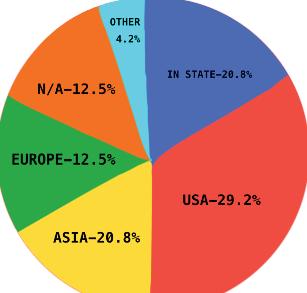
activities, possibly due to other commitments.
Summer break is also a popular time for watching movies, and students watched a wide variety of films. According to the survey, the most popular new releases were Inside Out 2, Deadpool, and Wol -
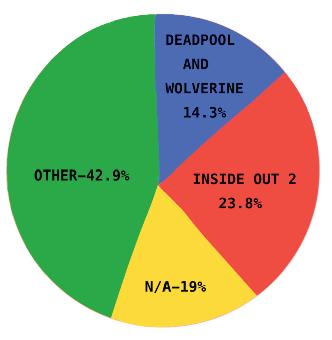
Out of the surveyed, about one-fifth of students had a summer job, while nearly one-third attended a summer program. Only about one-fifth participated in a summer camp, and the remaining one-fourth of students did not engage in any of these
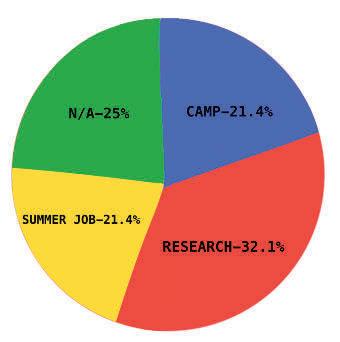
er accounted for over onethird of students’ favorite movies during the summer.
About one-fifth of students either did not watch a movie or did not have a favorite. The remaining half of the respondents had diverse preferences, naming films such as The Pope’s Exorcist, Liar Liar, Blue Beetle, Twisters, Didi, and The Sixth Sense. Additionally, several students watched the widely discussed double feature of Barbie and Oppenheimer. Overall, Inside Out 2, Deadpool, and Wolverine emerged as the most popular choices among students.
Movies and television were not the only forms of entertainment, as many students also spent their summer reading books. About two-thirds of surveyed students reported reading books over the summer. A variety of books were read, but no specific genre or type stood out. About one-third of the students did not read any books during this period.
That concludes the students’ summer recap. The survey results provide a glimpse into the diverse ways students spend their time, offering potential inspiration for future summer activities.
Overall, the survey responses indicated that many students had an eventful summer, with a majority expressing satisfaction with their experiences. And now that summer is over, everyone should strive to have an equally if not more eventful school year.

By Sheil Mody and Vincent Yang
Editor & A&E Editor

A tall figure slices through the water of Ohlone College’s swimming pool, rapidly advancing towards the other end of the lane as the sun peeks out from under Mission Peak. Rising at 5:30 in the morning to swim requires an intense level of commitment, the kind that blurs the line between discipline and psychopathy. One might think that the aforementioned individual is an Olympic swimmer, or maybe a lifeguard in training, but no— this is just a common morning routine for Justin Ely, a senior at BASIS Independent Fremont Upper (BIFU), doing his laps before a fresh day at school. An athlete, a teacher, a scholar, and possibly a tripod fish, he can be frequently spotted at the local
Ohlone College swimming pool or at swimming tournaments all over the West Coast.
“I love swimming as a sport and I kind of depend on it to a certain extent,” said Justin, “Some days if I don’t swim, I just feel unenergized and sleepy.”
However, Justin values swimming as more than a physical activity.
“I guess more than the sport I love the community; I’ve really grown up with my teammates,” he says, “I see them almost every day so it really creates a sense of family that you don’t really get in many other places.
The understanding of the importance of community imparted on Justin through his swimming experiences is something he brings everywhere he goes, whether it be in the classroom, his physics club at BIFU, or during his weekend volunteering with special needs children.
“If you’re having a mundane week, the children there are always smiling,” says Justin. “The child I coach loves to talk and teaching him is a refreshing experience for the soul.”
One can thus infer that Justin’s role in the BIFU community is incredibly strong, and the student body provides no shortage of positive remarks about his presence and conduct.
“Justin is very patient, considerate, funny, and smart,” said Anruo Zheng (12), a close friend of Justin. “His mastery in every single aspect of life is probably the most unique thing about him in our community.”
Justin is always eager to assist anyone in any way he can, ranging from tutoring to helping with microtasks.
“Justin always took time out of his day to properly explain competitive physics concepts to me, even when my incompetence was caused by my negligence in class,” said Kevin Zhou (12). “He’d explain derivations, take me step by step through problems, and clarify my plethora of misunderstandings.”
Justin can always be seen trying to improve his knowledge in one field in another, whether it be furiously deriving complex math equations in his CJ to prove something to himself or understanding new languages such as German.
“During the F=MA exam, I struggled to solve a problem on the test,” said Justin. “The next day, I woke up at 5:30 and laid in bed thinking about this problem. I realized that my methodology was wrong, and once I went to school, I resolved the problem, obtaining an answer I was happy with.”
Justin is also always eager to discuss his hobbies of cardistry, photography, calligraphy, and electrical engineering in his garage. His most recent project included building a functioning Tesla coil. Justin’s photography hobby is shown through his extreme enjoyment in his junior year photography field trip to San Francisco and his montage of his stuffed animal penguin with many different backgrounds.
His humility is notable, but his aspirations are great; when asked what his greatest accomplishment during his lifetime was, we received a very humorous, yet insightful response.
“I have absolutely no clue. I’m a seventeen-year-old. Come back and ask me in thirty years.”
Justin hopes to master many new hobbies and reach new heights in his career. To him, the future is not daunting, but rather a plot in which seeds of success can flourish.
Justin also has a very prominent talent in physics and is one of the star students of every physics class at BIFU. Students around the campus know him well from his extraordinary knowledge of the subject.
“I wonder how he’s so good at physics,” said Aditi Kiran (12).
His vast intellect on the subject is due to the immense time he has spent and the intense work he has done regarding the field, whether it be USAPHO or having thought-provoking discussion with his teachers.
One of Justin’s largest fears is quite philosophical, and it provides another avenue into understanding the cognitive machinery that pilots his flesh-and-bone corporeal form, “I fear running out of time whether it be on a small assignment or fulfilling my dreams in my lifespan.” He turned his fear into some advice for all our readers: “When you need to work, work hard, and when you’re having fun, have fun hard.” Whatever you may be doing, put in all your effort and make the best use of your time.
Justin Ely is a well-known figure in the BIFU community, whether it be for his mastery of an indiscriminate skillset used to impress and entertain his friends, his willingness to assist anyone, or his recognition in the field of physics.
“BIFU is a very unique experience compared to most high schools. It’s a tighter community and people should interact with each other more,” said Justin, “You should take advantage to get to know your peers and teachers around you better.”
By Selena Peng and Ailsa Wu
Feature Editors
Inside the MPR on a late Wednesday afternoon, several determined athletes pant and sweat, hard at work training for an incredible athletic feat. These are members of BASIS Independent Fremont Upper (BIFU)’s Marathon Club, which is back in session after a successful inaugural year and aspirational for an even more fruitful second year of establishment. The Marathon Club is one of our school’s many unique athletics-focused extracurricular offerings, providing a place where runners from any skill level can train to become faster and better athletes, and even prepare to comfortably run a half-marathon at the end of the year. Driven by their shared passion for long-distance running, the founders of the club Anuj Patel (11) and Yagnik Chilamakuri (11) started this endeavor in the 2023-2024 school year to bring the enjoyment of long-distance running to the students at BIFU.
By Shubh Bachkethi Staff Writer
BASIS Independent Fremont Upper (BIFU) has ushered in a slew of changes to its curriculum for the 2024-2025 school year, from shortened classes, to new credit requirements for graduation.
Ever since its opening in 2019, BIFU has undergone numerous changes in staff, schedules, and extracurricular activities. Beloved teachers have left, and new teachers have joined our community since. Once, students could only dream of seeing the world beyond school with their classmates and teachers. Now, the school offers term project options like hiking, along with exciting national and international trips. But these changes are just the tip of the iceberg.
Let’s take a closer look at the classes themselves. When we think back on
To train for long-distance running events, such as the half-marathon, the club meets two times a week to strengthen their runners’ athletic abilities and confidence in running. Once a week, they meet up after school to do general fitness training and build athletic ability, and on weekends they meet at Lake Elizabeth to run. They start with one mile per run and strategically and gradually increase the distance throughout the year to prepare their runners for the 13-mile run awaiting them. The club goes beyond preparing members through training to also provide them with nutritional advice as well as healthy snacks to fuel runners through their intensive workouts.
This past year, five members from the 2023-2024 Marathon Club successfully completed a half-marathon at Lake Elizabeth after extensive preparation throughout the school year. The run was difficult, as is expected from any athletic feat that requires such endurance and stamina.
However, the Marathon Club members persevered through consistent training, proper nutrition, and hydration. “We made it through the run by being consistent and staying determined, a mindset that [we] developed in [our] training throughout the year”, said Darius Lo (11). Upon completing the race, the club mem -
our classes, we often associate them with the scores we earned. However, many older students reminisce about courses that no longer exist. For example, in the 2022-2023 school year, BIFU required Health class and two Logic classes each week. Now, Logic has been replaced by a combined PE/ Health class. Economics, which was once offered in eighth grade to prepare students for AP Microeconomics and Macroeconomics, has also been replaced by PE/Health.
Tycho Young (10), part of the last class to fully experience the old schedule, voiced his opinion on the matter.
“I don’t think Economics should be brought back for eighth graders,” he said. “AP Econ is not too difficult, and since it’s a graduation requirement, there’s really no reason for students to take it in eighth grade.”
Thanisha Thambidurai (9) said she feels neutral about the change.
“I think Econ should be brought back to eighth grade, but it wouldn’t make much difference to me”, said
bers received t-shirts and medals to celebrate.
After ending the club year with a half-marathon, they are back and even better. As the club continues to grow every year, new events are being added to better prepare club members. Patel stated that with the new school year, the club is looking towards including even more long-distance running events; for example, the club may be adding ten-kilometer runs throughout the year.
With just one year of experience, the Marathon Club has already completed a remarkable achievement and is continuing to grow with its aspira -
tional plans this coming school year. Though the current extracurricular season has already started, the club advisors hope that their club will attract more members next year.
As for why people should join, Patel puts it best.
“All [running] takes is determination and mental strength. At the end of the day, you could walk thirteen miles and it wouldn’t be as bad,” he said. “But if you run it, you’ll actually feel good at the end because you accomplished something so large. And that’s a great achievement to have in your lifetime.”

Thambidurai, “I’m not really interested in economics, but for those who are, it could be a good precursor to other economic courses.”
Josh Peter (11) voiced his thoughts on Logic being canceled.
“I wish it would make a comeback”, said Peter. “I think it’s useful to teach students how to think logically and avoid fallacies.”
In conclusion, the curriculum changes for the 2024-2025 school
year at BIFU show the school’s dedication to moving towards an evolving learning experience. While students express mixed feelings about these shifts, their reactions underscore the diverse range of perspectives on campus. Only time will tell how these adjustments will shape the educational journey, but one thing is clear: BIFU remains a dynamic environment, continuously shaped by the needs and voices of its students.
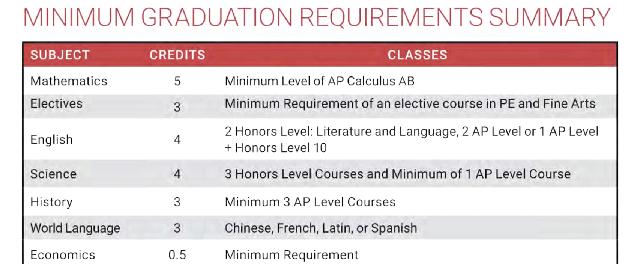
By Selena Peng and Ailsa Wu Feature Editors
Disclaimer: The following article may contain spoilers for Dìdi
“Dìdi” by Sean Wang perfectly embodies relatability and nostalgia. Released this past summer, the feature film tells a down-to-earth, raw, and realistic coming-ofage story set and filmed right here in the East Bay.
Directed by Fremont native Sean Wang, “Dìdi” follows a 13-year-old Tawainese-American boy named Chris Wang, known endearingly by his close friends as Wang-Wang, through the summer before his freshman year of high school in 2008. As the story progresses, viewers see both the highs and the lows of Chris’s life as he navigates being an Asian-American teenager – from scoring a date with his crush to falling out with his friends to putting his identity on the line to fit in with a group of cool skateboarders.
The film also takes viewers through Chris’s family life in a Taiwanese immigrant household with a loving, yet at times strained family dynamic. The movie ends in a way that is neither sad nor happy, but perhaps hopeful as Chris takes what he has learned through his first teenage summer and begins high school.
What makes Sean Wang’s film “Dìdi” personal to us is that it was shot in our hometown, Fremont; it showcases many familiar locations around the Bay Area, such as Mission San Jose High School, Great Mall, Golfland, and several residential neighborhoods around the city. The use of real locations instead of artificial sets adds authenticity to the story. The film is also filled with influence from Sean Wang’s own childhood in Fremont, with parts of Chris’s house being filmed in Sean Wang’s own childhood home, and having the character’s room be designed with his own vintage decor.
The message of the movie is especially powerful because of how realistically it portrays an all-too-familiar story for its target audience. Chris, the main character, isn’t like other protagonists who are usually featured on the big screen. He isn’t mature for his age, or particularly talented or smart – just an awkward teenager with flaws and quirks, allowing his character to speak to so many other teenagers worldwide. The film doesn’t hide Chris’s uncomfortable moments; every fight with his family, every embarrassing Google search, and every stupid decision he makes due to peer pressure only makes his character seem more like a real kid. His actions in the film are a true embodiment of the spontaneity and naivety of a teenager.
Aside from being relatable to the general teenage audience, the movie truly focuses on the realities of growing up as an Asian-American in the early 2000s. Chris’s experiences throughout the movie mirror those of children of Asian immigrants, such as being spoken to in a second language at home but responding in English, or constantly being compared to other Asian kids by their parents.
The largest theme, however, that “Dìdi” focuses on is Chris’s struggle with his identity as a Tawainese-American. Throughout the film, it is clear that Chris would much rather embrace the “American” part of that identity. He is constantly demeaned for his ethnicity, whether through blatantly racist jokes or subtle microaggressions, like “you’re cute for an Asian”. These moments undoubtedly eat away at his self-confidence and cause him to feel the need to hide parts of his identity, including his family. For example, he goes by different names around different people: “Wang-Wang” with his fellow Asian friends, and “Chris” with a new group of nonAsian peers. His disconnect with his culture also widens the cultural gap between him and his family, with Chris often criticizing his family for being too Asian, and even running away from home.
By the end of the movie, it’s not exactly clear whether or not Chris was able to set Western prejudices aside and truly be happy with his identity, but with the help of valuable lessons that he has gained through hardships with both his family and peers, it seems like he’s on the right path.
Overall, “Dìdi” is a remarkable film about growing up, finding friendships, and building character. This story crafted by Wang is not only for a certain audience but for anyone who has felt as if they don’t exactly fit into specific societal standards. With the familiar shots of Fremont, this film hits close to home and reminds us that all of our stories and experiences do connect us. This film serves as a representation that it is important to find value in our communities as well as ourselves. Through the film work, cinematography, and storytelling, one thing is clear: growing up is a process full of curveballs, but also finding out who you truly are.

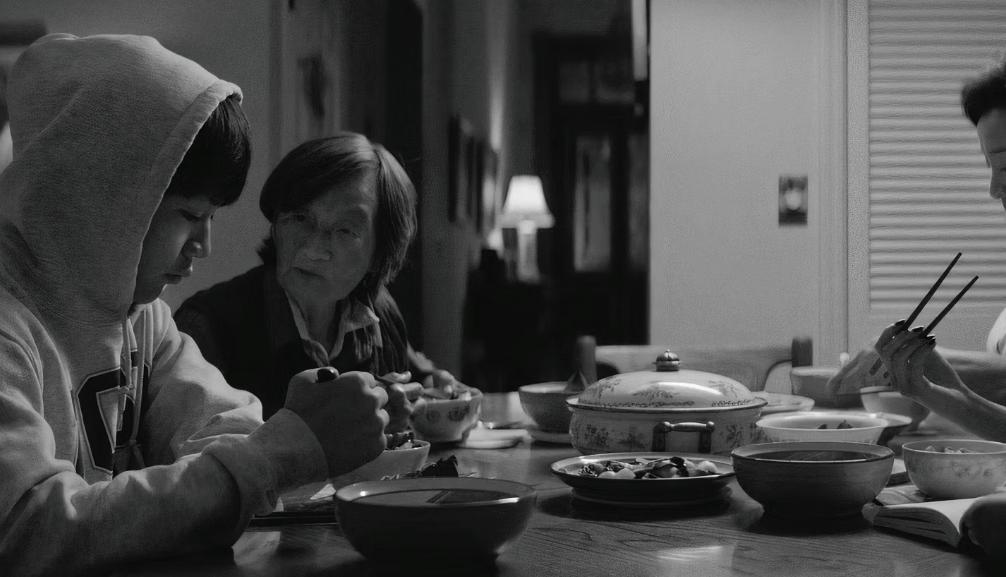

By Brandon Yu Staff Writer

kate in opening scenes of “twisters”, taken by universal pictures
Disclaimer: The following article may contain spoilers for Twisters .
Almost 30 years after Twister first roared through theaters and made its mark as a defining disaster movie, the storm has returned to theaters. Twisters, the highly anticipated sequel directed by Lee Isaac Chung, captivates the audience with its stunning visuals and action-packed scenes.
Twisters was released on July 19, 2024, by Warner Bros. Pictures and Universal Pictures. The movie became a huge box office success, grossing about $500 million worldwide, $200 million more than the last rendition of Twister.
The movie plot of Twisters starts with the main character, Kate, who is invited by her friend Javi to test a recently developed advanced tracking system. Throughout the movie, they travel with other groups of meteorologists in a hunt for twisters, a common, southern term for tornadoes. While traveling, they ex-
perience close encounters with storms and tornadoes around central Oklahoma.
According to director Lee Chung, the goal of the film wasn’t to make a statement.
“I just wanted to make sure that with the movie, we don’t ever feel like it is putting forward any message”, said Chung in a CNN interview, “I just don’t feel like films are meant to be message-oriented.”
Despite this, I believe the movie conveys a clear message — it pays homage to storm chasers for risking their lives to advance meteorology.
A standout feature of Twisters was its distinct portrayal of tornadoes. Instead of simply pursuing these storms, the protagonist, Kate, seemed to track them as if they were living entities haunting Oklahoma, adding a layer of suspense and intrigue to the storyline. The visual effects effectively captured the storms’ intensity and unpredictability, delivering breathtaking scenes that brought the weather of the American Midwest to life.
In contrast, the character performances varied in their impact. Daisy Edgar Jones, who took on the role of Kate, delivered a performance that occasionally felt less compelling com -
pared to the performance of her co-star Glen Powell, who portrayed Tyler Owens. Powell’s portrayal was both dynamic and engaging, carrying much of the film’s emotional depth. This variation in performances could have been addressed, as greater consistency among the cast could have enhanced the film’s overall narrative.
Overall, Twisters achieved significant success, both critically and commercially, earning $500 million at the box office and securing a 74% rating on Rotten Tomatoes. However, like all films, there remains potential for improvement, especially in maintaining consistent performances throughout the cast.

By Emma Ma Arts & Entertainment and Sports Editor
K-pop girl group LE SSERAFIM is back in the spotlight with their brand new album, “CRAZY”. With the release of multiple successful albums in the past, the most recent being fan-favorite “Easy”, LE SSERAFIM fans were confident that “CRAZY” would be another success. To build anticipation for this release, the group teased one of the tracks from their album, “1-800-hot-and-fun”, during their debut performance at this year’s Coachella, the annual arts and music festival in California. This proved to be the right move, as many fans were pleasantly surprised by how different the track sounded compared to their previous songs. Additionally, LE SSERAFIM’s trailers for “CRAZY” received an overwhelmingly positive reception, with the most popular one reaching 2.4 million views on Youtube. As soon as the music video for the title track dropped, social media blew up with countless netizens discussing their favorite lines and moments from the video.
The title track, “CRAZY”, is my favorite track on the album due to its incredibly catchy beat and fun, addicting lyrics. I actually disliked it when I first listened to it—I found it way too simple and lacking in complexity. It felt more like a backtrack to dance to then the title track of a studio album. While I still somewhat feel that way, I enjoy it much more after
“TASTE”
listening to it a few more times and seeing it all over social media. The choreography definitely makes me appreciate it more, as it’s very visually appealing, and the LE SSERAFIM girls pull it off perfectly. It incorporates vogueing, a modern house dance originating from LGBTQ+ ballroom scene of the 1980s.
“Pierrot” is a track that, similarly to “CRAZY”, sounds very simple. The song’s structure is nothing new, and the chorus reminds me of other songs I’ve heard before. Despite that, I still enjoy listening to it because it’s incredibly catchy. I can’t help but nod my head to the beat.
“1-800-hot-n-fun” is a perfect example of a track that I’d usually never listen to. I’m not a fan of songs where the artist(s) sound like they’re just talking, and that’s what the majority of this track is. It’s also extremely repetitive, which makes it feel even shorter than it already is. However, this song is amazing for performances because it radiates confidence and charisma, which the girls can definitely pull off perfectly on stage. I really loved their Coachella performance because the festival atmosphere is perfect for a party song. With some fun facial expressions and full energy, the girls can make “1-800-hot-n-fun” a song worth paying attention to.
Lastly, “Crazier” is just another boring ballad that sounds completely identical
By Aarna Kamath and Pooja Kanthala Arts & Entertainment Editor and News Editor
Sabrina Carpenter is currently the #1 pop star with her 2024 VMA “Song of the Year” award for Espresso and the release of her sixth studio album, Short N’ Sweet. Following Espresso, the most popular song on her newest album is Taste, with over 185 million streams. Taste immediately became a fan favorite due to its catchy melody, relatable lyrics, and upbeat soundtrack. However, what took fans by a storm was the music video, which features fan favorite actress Jenna Ortega.
While Ortega originally garnered her audience from her role as Harley Diaz in Disney’s Stuck in the Middle, her later roles have largely diverged from that genre. Some of her recent roles include Beetlejuice (2024), Scream IV (2023), Wednesday (2022), and Scream (2022), all of which are spooky or horror films. Ortega’s fans largely agree that these roles suit her well. “I think Jenna Ortega’s successful in her acting career because she gives off a unique and mysterious vibe and that’s what the audiences like,” says an anonymous 11th grader. “And of course she’s a very talented actor.”
However, Ortega’s typical genre contrasts vastly from Carpenter’s reputation for more upbeat and light-hearted roles in films and television shows such as Work It (2020), Tall Girl (2019), and Girl Meets World (2014). Furthermore, Carpenter’s aesthetic when it comes to all
her work, including her generally peppy music, is bright compared to Ortega’s mysterious one.
“Sabrina Carpenter just has that bright personality that you can clearly see in the work she does,” Paisli Davé, an 11th grader, says with a smile. “You can also see it in her aesthetic too, in terms of her makeup and music.”
Due to the difference in the roles both women typically play, fans were pleasantly surprised to see Ortega star in the music video. The music video itself combines the two aesthetics of both Orgeta and Carpenter, featuring both gore and bright colors. “I liked the color scheme in general,” says Katherine He, an 11th grader here at BIF. “It was bright which matches Sabrina Carpenter’s aesthetic and the actions in the music video matches Jenna Ortega’s aesthetic.”
The music video itself reached over 65 million views on youtube and was hugely successful, not just due to the popularity of the song itself, but also to the iconic and unexpected colla boration between the two stars.

to the countless other K-pop ballads. It brings absolutely nothing to the table—no fun instrumental, no outstanding vocals…nothing. This is definitely a downgrade from their previous ballads; it feels like their producers ran out of ideas and opted for the simplest track to play it safe. There’s nothing wrong with releasing slower paced and more vocal heavy tracks, but they should still sound unique. Their older songs like “Sour Grapes” and “Impurities” are perfect examples of slow tracks that are still distinct and fun to listen to. In comparison, “Crazier” offers nothing that makes me
want to give it another listen. In conclusion, “CRAZY” has some hits, but still falls short for me compared to their previous releases. In my opinion, their debut album, “Fearless”, and their second album, “Antifragile”, remain the strongest in their discography. They’re the most unique in terms of production and sound in general, while their recent releases feel much blander. Instead of leaning into the party girl concept, I wish they’d return to their earlier concepts of fearlessness, because that’s what set LE SSERAFIM apart from other girl groups in the industry.

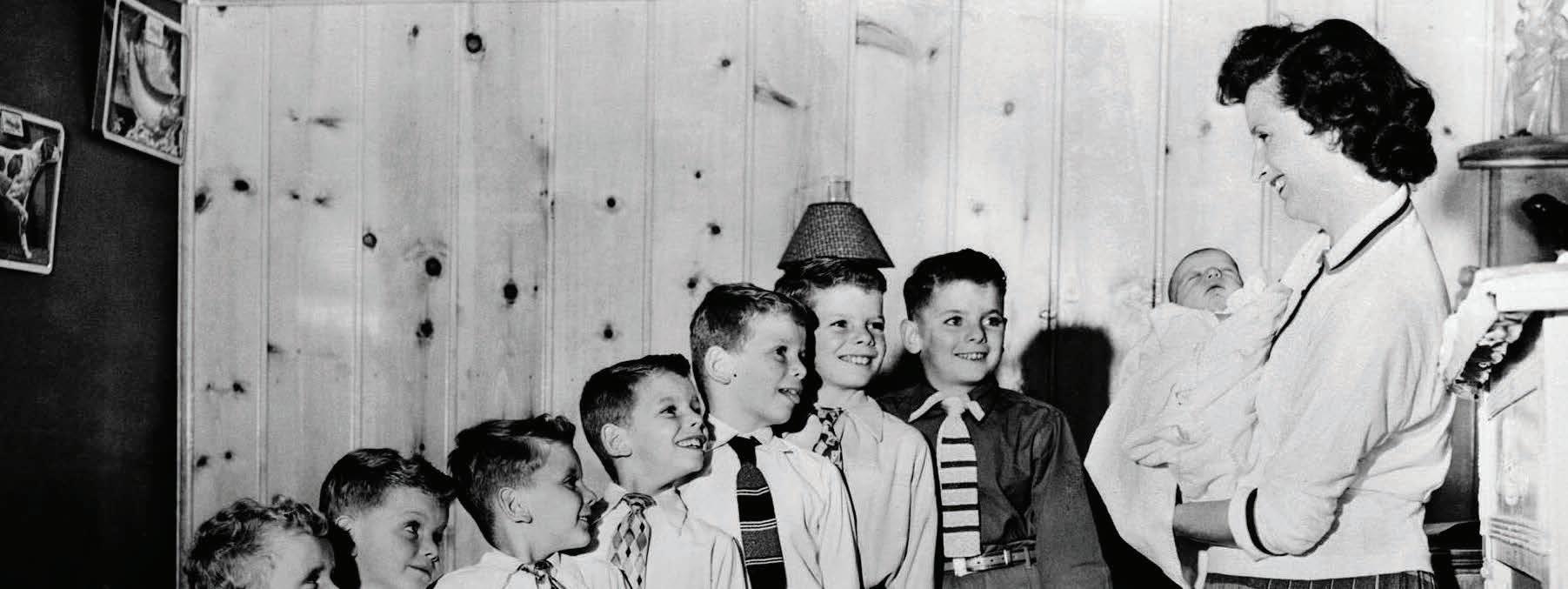
“How many Einsteins have spent their lives washing dishes, how many Mozarts bent over stoves instead of pianos, because they had the misfortune of being a woman,” said Youtuber Funkyfrogbait in their recent video, titled “The TRAD WIVES of Tiktok.” In the video, Funkyfrogbait reminds their audience of the lost potential of all the women who take on this lifestyle, just like Maria Anna Mozart did. On the social media platform TikTok, many women posted short videos highlighting how they were motivated by the quote, and determined to pursue their passions. Their quote rekindled the internet’s interest in the contemporary feminism movement, and gave the world a reminder: the fight for feminism is not done yet.
The Mozart surname needs no introduction. Yet few people know of Maria Anna Mozart, Wolfgang Amadeus Mozart’s sister. More importantly, she was a remarkable musician, traveling Europe with her brother, performing in the Mirrors Room at Schönbrunn Palace for the young Marie Antoinette. However, she was a woman; and thus, her passions were cut, and her piano strings snapped at eighteen when she was ready to marry. Her article in Britannica consists of only twenty-four words, eleven of which are related to her brother. Today, Maria serves as a testament to the talent that is lost to the vices of marriage, the obscuring of history, and the unfair sacrifice of women in today’s society.
While historically feminists have fought for suffrage, modern-day feminists continue to fight for social inequalities that propagate due to social pressures and cultural issues.
In some ways, feminism is regressing, with the glamorization of a “traditional”
lifestyle on social media, where stay-athome moms, also known as “trad wives.” The concept of the “happy homemaker”, which originated in the 1950s, has resurfaced under a different name, and social media is pushing a narrative where women are once again responsible for household chores, taking care of children, and cooking. Trad wives have glamorized a lifestyle where women were expected to give up their lives in exchange for a family, encouraging women to settle down early, with their life’s purpose tied to a ring.
While traditional wives aren’t necessarily the problem, those who unfairly portray aspects of that lifestyle as positive may give social media users an unhealthy perception of reality. This comes from the nature of social media, in which users only post the best moments of their lives, while leaving out the rest.
This misguided perception that trad wives have perfect and fulfilling lives could be damaging, as encouraging young women to pursue a family before a career leaves them at a large economic disadvantage—especially when considering the fact that according to Forbes, 43% of first marriages end in divorce, leaving the woman to find a job without experience or education.
Trad wives all have their own stories to tell. Many former trad wives on TikTok have taken it upon themselves to teach the younger generation–“Notice how there are no women in their thirties preaching the trad wife lifestyle?” They’ve experienced firsthand the limitations and isolation conducive to this kind of role.
“These women are trapped.” said Allison K, a former trad wife, “these women, a lot of them don’t even know they are trapped.”
By Vera Lin and Josh Peter Feature & Sports Editor and Opinion Editor

Fantasy football has been at the forefront of conversation starters and student discussions at BASIS Independent Fremont Upper (BIFU). With over 30 million players in the United States participating in the online game, fantasy football has transformed the way fans interact with football, turning casual spectators into passionate participants.
In fantasy football, participants use their knowledge of the sport to compete against each other in formats that relate to the actual performance of professional football teams. Every week, one aims to set his or her ideal lineup by swapping players out from the bench or trading with other teams. The goal of the online game is to score points and achieve a position on the leadership board by beating the opponents in one’s league.
The idea of the unpredictable and exhilarating game first sprouted in 1962 as a hang-out activity for a few businessmen, but has grown into a way for fans around the world to participate in their beloved sport. Today, the fun part of Fantasy Football still lies in the individualized data generated by real-world events.
“I’m more interactive with the sport now, so it really made me like it again”, said Kevin Yan (12), who recalls a similar effect from playing the game. “It’s led me to watch more football and support my team.”
As the players tap into their competitive spirits, they incorporate various strategies to achieve their success in Fantasy Football. For some, like Yagnik Chilamakuri (11), the excitement of winning drives them. He stays sharp by making calculated draft picks and doing research before the draft. This meticulous planning reflects the deeper thought that goes into selecting players, especially when it involves risks — and his current winning streak.
But it’s not just about playing it safe. Risks are a necessary part of the game. Yan took a gamble by picking up
a quarterback this month, only for the player to get injured shortly after.
“I picked up this one quarterback on Thursday afternoon and he bonked his head and he’s gonna be out for a long time,” said Yan.
Strategizing, of course, goes beyond the draft. Players like Akash Singh (11) study matchups meticulously. It’s this attention to detail that defines a successful Fantasy Football player — balancing the unpredictable nature of sports with well-thought-out tactics. Chilamakuri even goes so far as to incorporate bribery in his strategy.
“Sour Patch Kids are my secret weapon”, said Chilamakuri.
When it comes to trades, however, it’s a game of trust—or lack thereof.
“I ignore every trade offer from Kevin,” said Aarav Kumar (12), pointing out the psychological warfare that underscores every interaction in Fantasy Football. “It’s always in his favor.”
Yan, on the other hand, never trades with Kumar, making sure to keep his rival at arm’s length. For others like Singh and Patel, trading hasn’t played a major role yet, but they know it’s a tool they may use to tip the scales in their favor once the stakes get higher.
Fantasy Football doesn’t just deepen the competitive bonds between friends—it brings them closer to the sport itself. Whether it’s Singh, Patel, or Yan, many find themselves becoming more invested in football, tracking their players in real-time to see how their Fantasy teams will fare.
“It just takes one of my favorite things in the world, sports, and combines it with a game,” said Kumar. “I really like that dynamic of how real-life sports impact playing with friends.”

By Nick Yin Staff Writer
Every four years, when the Olympicsseason rolls around, millions of people around the world turn on their TV to tune in to the wonderful and exhilarating Olympic Games. After all, no one wants to miss the spectacular moments throughout the games. However, directly after the Olympics, there is a neglected sporting event known as the Paralympic Games. These games are the same thing as the Olympics, but catered towards disabled people. These games are forgotten by not just the common people, but also major news networks that have the ability to broadcast the games. Today, I want to get to the bottom of this and figure out why exactly people are ignoring the Paralympics.
One of the main causes of this neglect is the unfortunate timing of the Paralympics. Not only does it begin right after school, it is also positioned right after the Olympics, a period of time when most people have what is called “Olympic Fatigue”. After two weeks of intense Olympic-watching, most people become tired of watching sports. This fatigue combined with increased workload from school or college make the Paralympics much less popular than the Olympics.
Another factor is related to the availability of the Paralympics. During the Olympic season, the news would cover the wins and losses of each day unrelentlessly. Every morning, major news channels report the wins and loses of the Ol ympics, but when it comes to the Paralympics, the news basically forgets about it until the last day, when the scores are tallied up. If people can’t access the Paralympics as easily as they can the Olympics, they are not going to spend forever looking for channels that just so happen to broadcast the Paralympics. They will sim ply pretend it doesn’t exist, and throw it to the back of their heads.
The final factor that impacts the results a lot is the fact that not a lot of
people know that the Paralympics exist. This is due to the absence of advertisements and whatnot relating to the Paralympics. This lack of ads is mostly caused by the low advertisement value of the Paralympics compared to the Olympics.
When Jason from 8th grade told me his opinion on this matter, he said that he didn’t know it was a thing. He believed that the main reason people didn’t watch the paralympics is because they didn’t know about the Paralympics.
“The news should make it more well known by making ads about it if they want more people to watch the games,” he said.
When I asked the same question to Neil from 8th grade, he told me that the Paralympics weren’t as available as the Olympics.
“I tried to watch the Paralympics, but I couldn’t find anywhere that broadcasted it live,” he replied.
But when this question was asked to Shardul from 8th grade, he said that the Paralympics weren’t fast-paced enough.
“The Paralympics are too slow-paced, and it isn’t as exciting as the Olympics,” he stated.
Now that we have identified all the main factors that contribute to the unpopularity of the Paralympics, let’s discuss how to get more people to watch the Olympics.
First of all, we could obviously just give it more media attention, allowing it to be recognized by more people around the world. It has the potential to reach a larger audience, but many people just don’t know it exists. We could also make the games more accessible by broadcasting it on major news channels, making it easy to access by the common people.
All in all, whatever the problem is, these Paralympians deserve our respect. Even though they have disabilities, they still fight for their country and their own personal glory. That is the true spirit of the Olympics.

Editors-in-Chief: Katherine He, Julee Jiang, and Olivia Ma
Editors: Angela Cao, Aarna Kamath, Pooja Kanthala, Vera Lin, Emma Ma, Sheil Mody, Sachit Parekh, Selena Peng, Josh Peter, Thanisha Thambidurai, Ailsa Wu, Sarah Wu, Vincent Yang, and Tycho Young
Staff Writers: Shubh Bachkethi, Angela Cao, Aaron Ely, Hemangi Ghimire, Aarna Kamath, Pooja Kanthala, Vera Lin, Natalie Luo, Chen Ma, Emma Ma, Sheil Mody, Sachit Parekh, Olivia Peng, Selena Peng, Josh Peter, Thanisha Thambidurai, Ailsa Wu, Sarah Wu, Vincent Yang, Nick Yin, Tycho Young, and Brandon Yu
Graphic Design: Katherine He, Julee Jiang, Olivia Ma, Selena Peng, and Ailsa Wu

Thank you for reading the first issue of the fourth volume of The Yellow Pages! We hope you enjoyed reading the issue as much as we enjoyed the process of creating it! If you have any comments, suggestions, questions, or notice any mistakes in our newspaper, please contact bifyellowpages@gmail.com . We will include corrections for our errors and typos in the following issue.